DRIVE DROVE DRIVEN
Autos in der zeitgenössischen Fotografie
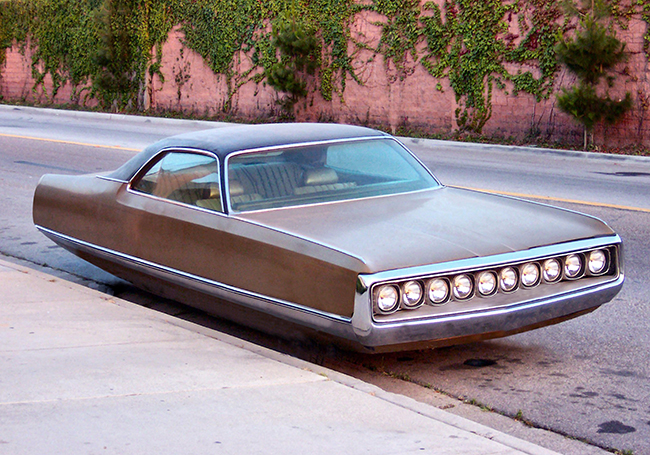
Ausstellung
28. Januar bis 8. April 2018
Eröffnung: Sonntag, 28. Januar 2018, 12 Uhr
Begrüßung
Heike Schmitt-Schmelz | Bezirksstadträtin
Elke von der Lieth | Kommunale Galerie Berlin
Einführung
Dr. Matthias Harder | Kurator
Nach der ersten Ausstellungsstation im fernen Omaha (Nebraska/USA) eröffnet die
Kommunale Galerie Berlin am 28. Januar 2018 die Gruppenausstellung DRIVE DROVE
DRIVEN, kuratiert von Matthias Harder, mit Werken von: Clara Bahlsen, Jürgen Baumann,
Xiomara Bender, Beni Bischof, Daniela Comani, Stephan Erfurt, Larry Ferguson, Aris Georgiou,
Oliver Godow, James Hendrickson, Charles Johnstone, Martin Klimas, Jens Liebchen, Serge
Marcel Martinot, Arwed Messmer, Ralf Meyer, Bernhard Moosbauer, Melina Papageorgiou, Philipp
von Recklinghausen, Christian Rothmann, Marc Volk, Maurice Weiss und Michael Witte.
Seit über 100 Jahren bestimmt das Auto das Alltagsleben vieler Menschen, und es gibt
gleichzeitig wohl kaum einen Gegenstand, der so sehr polarisiert. Autos sind Fluch und Segen
zugleich, Designwunder und Umweltkiller, Symbole für Flexibilität und Freiheit, Kultobjekte und
geradezu erotische Statussymbole.
All das wird von einer überaus innovativen Autoindustrie mit Werbebildern und -filmen befeuert
sowie von einer einflussreichen Autolobby unterstützt. Vor diesem Hintergrund entwickeln
Konstrukteure Automobile mit extremer Motorisierung und Beschleunigung und versprechen
dabei zugleich eine airbaggeschützte und neuerdings auch selbststeuernde Wohlfühloase. Für
manche Fahrer auf deutschen Autobahnen ohne Tempolimit erfüllt sich die Sehnsucht nach
unendlicher Freiheit, und gleichzeitig kommt es dort immer wieder zu tödlichen Unfällen.
Schon die Futuristen hatten Anfang des 20. Jahrhunderts bekanntlich die Geschwindigkeit des
Autos zum ästhetischen Prinzip und zur Konstante der Moderne erklärt – und empfanden einen
„Rennwagen schöner als die Nike von Samothrake“. Später entwickelte sich das Auto schlechthin
zur Metapher für kollektiven, kleinbürgerlichen Wohlstand, war Ausdruck eines besonders
auffälligen Designs oder stand für Individualismus. Doch wenn in den heutigen Schwellenländern
und zukünftigen Weltmächten Indien und China mit ihrer Milliarden-bevölkerung die
Automobilisierung weiter so rasant verläuft, wird die Menschheit bald keine Luft zum Atmen
mehr haben – trotz der Weiterentwicklung von Elektro- und Hybridantrieben.
In der modernen und zeitgenössischen Kunst war und ist das Auto immer wieder zentraler
Bildgegenstand, etwa bei Andy Warhol und Arman, bei Sylvie Fleury und Gabriel Orozco; auch in
den Filmklassikern „French Connection“ und „Bullitt“ sowie in vielen James-Bond-Abenteuern
spielen schnelle Wagen eine tragende (Neben-)Rolle. Auch zahlreiche internationale
zeitgenössische Fotografen haben das Auto zum Thema gemacht und kongeniale Ikonen
geschaffen, parallel zur werbenden, das Auto als Ware anpreisenden Abbildung.
Die Gruppenausstellung stellt 23 künstlerisch arbeitende Fotografen mit völlig unterschiedlichen
Einzelwerken oder Bildserien exemplarisch vor: Wir werden konfrontiert mit Bildern von Unfällen
und leeren Straßen, parkenden oder wild abgestellten, verfallenden Autos, mit Oldtimer-Rallys
und gleich mehrfach mit dem sprichwörtlichen Unterwegssein im Auto – ein Beispiel dieser
Auswahl: So futuristische Autos wie von Beni Bischof haben wir noch nie in unseren Straßen
gesehen - manche scheinen zu schweben, andere besitzen zu viele Scheinwerfer oder gar keinen
Fond für die Fahrer und Beifahrer. Bischofs digital veränderte Autos wirken wie am Fahrbahnrand
abgestellte Mini-Ufos aus einem skurrilen Science-Fiction-Film.
DRIVE DROVE DRIVEN präsentiert unterschiedliche Automodelle und künstlerische Ansätze in
über 60 Aufnahmen sowie ein vielschichtiges Gesellschaftsbild, in dem ein Abgesang auf unsere
automobile Gegenwart genauso aufblitzt wie die noch immer weitverbreitete Faszination für den
schlichten Gegenstand – zwischen Alltags- und Designobjekt. Konzeptuelle Interventionen
stehen neben soziologischen Untersuchungen, Autos werden ästhetisiert, marginalisiert oder
ausgewählte Details zum Close-up. Wir begegnen dem Auto hier wie in einem Roadmovie immer
wieder als Hauptdarsteller und gleichzeitig markiert diese erste Berliner Ausstellung
zeitgenössischer Fotografen zum Thema Auto einen Übergang in eine ungewisse mobile Zukunft.
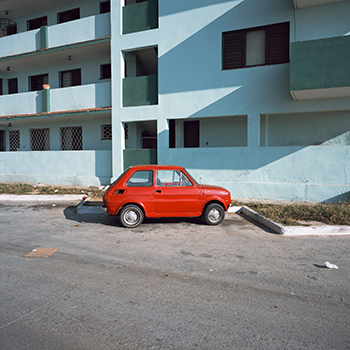
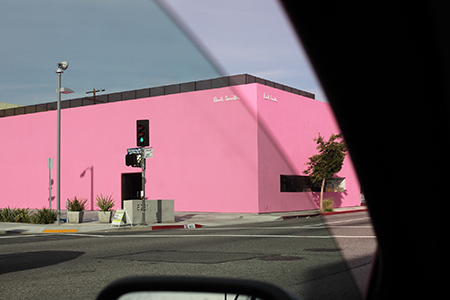
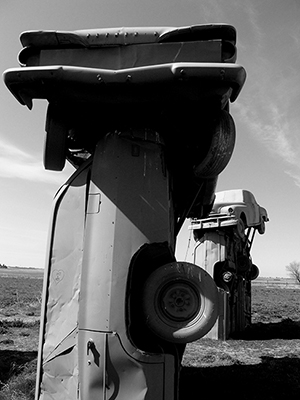
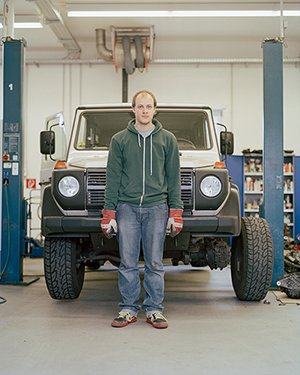
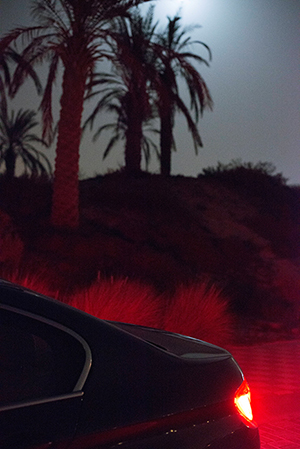

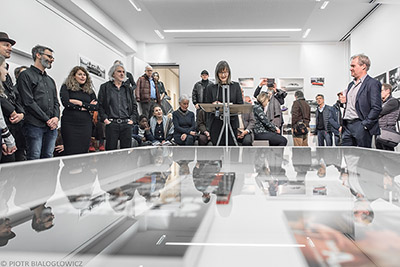
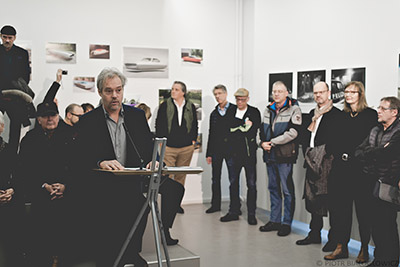
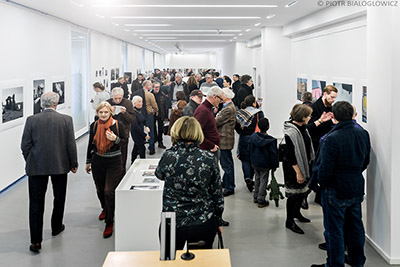
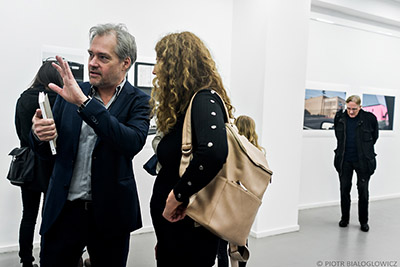
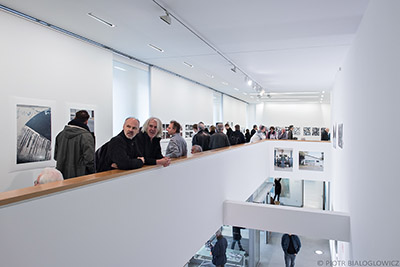
Fotos: Eröffnung am 28.1.2018, am Rednerpult: Elke von der Lieth, Dr. Matthias Harder, © Piotr Bialoglowicz
Abb. oben: Beni Bischof, o. T. (Handicapped Cars), 2014
After the first exhibition stop in Omaha (Nebraska/USA) the Kommunale Galerie Berlin will
open the group show DRIVE DROVE DRIVEN, curated by Matthias Harder, on 28 January
2018, featuring works by: Clara Bahlsen, Jürgen Baumann, Xiomara Bender, Beni Bischof,
Daniela Comani, Stephan Erfurt, Larry Ferguson, Aris Georgiou, Oliver Godow, James
Hendrickson, Charles Johnstone, Martin Klimas, Jens Liebchen, Serge Marcel Martinot, Arwed
Messmer, Ralf Meyer, Bernhard Moosbauer, Melina Papageorgiou, Philipp von Recklinghausen,
Christian Rothmann, Marc Volk, Maurice Weiss, and Michael Witte.
For more than a century, cars have had a decisive impact on our daily life, and few other
commonplace objects have so divided public opinion. Cars are both curse and blessing, design
sensation and environmental killer. Going beyond their pragmatic role as a means of transport
and transportation, they serve a social function that is far from neutral. Cars are projection
surfaces for desires and aspirations, as tokens of flexibility and freedom, and status symbols
connoting power, wealth, prestige, and sex. Highly innovative automotive industries in countries
such as Germany, Italy, and the United States cultivate this aura through compelling advertising
images, bolstered by an influential car lobby. Against this backdrop, design engineers develop
high-performance vehicles with turbocharged motors and fast acceleration paired with the
promise of an oasis of well-being: airbag-protected and, more recently, self-parking, with selfdriving
“autonomous” systems in the works. In Germany, the absence of speed limits on many
sections of the Autobahn highway system allows people to ride the roads at breakneck speeds
like a Formula One race car. Though this might fulfill drivers’ thirst for life in the literal fast lane,
it also leads to tragic accidents, time and again.
In 1973, British writer J.G. Ballard wrote Crash, a dark parable on our obsession with speed and
the erotic thrill of being in a car accident, which was spectacularly filmed by David Cronenberg in
1996. A number of photographers took up the theme in their own medium, Helmut Newton
notably among them. In the early twentieth century, the Futurists declared the speed of a car to
be an aesthetic principle and a fundamental aspect of modernity, declaring that a “racing car…is
more beautiful than the Nike of Samothrace.” Later, the car became the metaphor par excellence
for collective middle-class prosperity – examples include the Ford Model T in America and the
Volkswagen Beetle during the Third Reich and then in democratic Germany. Cars have been
endowed with eye-catching design – as seen in early models of the Citroën, Mercedes, and
Ferrari – or celebrated as a sign of individualism, with limited series cars and personalized car
tuning offered as a unique selling point.
At the same time, cars are responsible for air pollution, rising carbon emissions, and trafficrelated
deaths around the globe. If rapid motorization continues at its current rate in the
emerging and future world powers of India and China with their population of billions, humanity
will soon have no more air to breathe – despite the development of electric and hybrid engines.
Yet this has done nothing to stop the annual car shows and salons in Detroit, Geneva, Paris, and
Shanghai, which draw millions of visitors. In terms of private use, there are two prevailing
ideologies that are diametrically opposed: for some, the car should be luxurious both inside and
out, while others seek an “eco-friendly” solution that reduces harmful emissions – this is one
reason why car-sharing in Europe is gaining in popularity. At the beginning of the twenty-first
century, it has begun to dawn on us that relying exclusively on internal combustion engines –
which depend on the increasingly rare and expensive resource of oil in the form of gasoline –
makes less and less sense, and is also disrespectful to nature. Most Europeans cannot
comprehend the American preference for gas-guzzling SUVs, yet Germany in particular enjoys
the international export of its fast luxury cars, now mainly to Asia, with the number of
consumers able and willing to buy them growing year by year. Since the invention of the first
gasoline-powered automobile engines by Gottlieb Daimler and Carl Benz in 1885, countless cars
have been screwed, welded, and even glued together, and human hands have been succeeded
by fully automated production lines. The vast majority of cars are scrapped and recycled, while
more than a billion cars currently roll on the roads worldwide.
In modern and contemporary art, the car has repeatedly figured as a motif, from Andy Warhol
and Arman to Sylvie Fleury and Gabriel Orozco. It has starred in film classics such as The French
Connection and Bullitt, not to mention the many James Bond adventures where BMWs or Aston
Martins often play a key (supporting) role – depending on how much the manufacturers bring
into the film budget. And contemporary photographers on both sides of the Atlantic have created
iconic images that take the car far beyond its commercial depictions as a mere commodity.
Here, 23 photographers are introduced with incredibly diverse individual works and series that
represent the bandwidth of today’s artistic approaches to this beloved theme. We are confronted
with images of accidents and empty streets, of cars that are neatly parked or abandoned and
deteriorating, of vintage car rallies with their museum-like display, photographic destructions
and collages, and several interpretations of the proverbial state of being “on the road.”
The selection offers a multifaceted view of society that reveals both a requiem for our car-driven
civilization and an ode to our never-ending fascination with the car in its many incarnations –
from household asset to design icon. Conceptual interventions stand alongside sociological
studies, as cars are beautified, marginalized, or magnified in their detail. We encounter the car
as the protagonist of a veritable road movie, even as the car has lost its topmost ranking among
the possessions most desired by Europe’s millennial drivers. While this unique exhibition of
contemporary photography dedicated to the car signals our shift into a high-tech mobile future,
the future of cars themselves is marked by uncertainty.